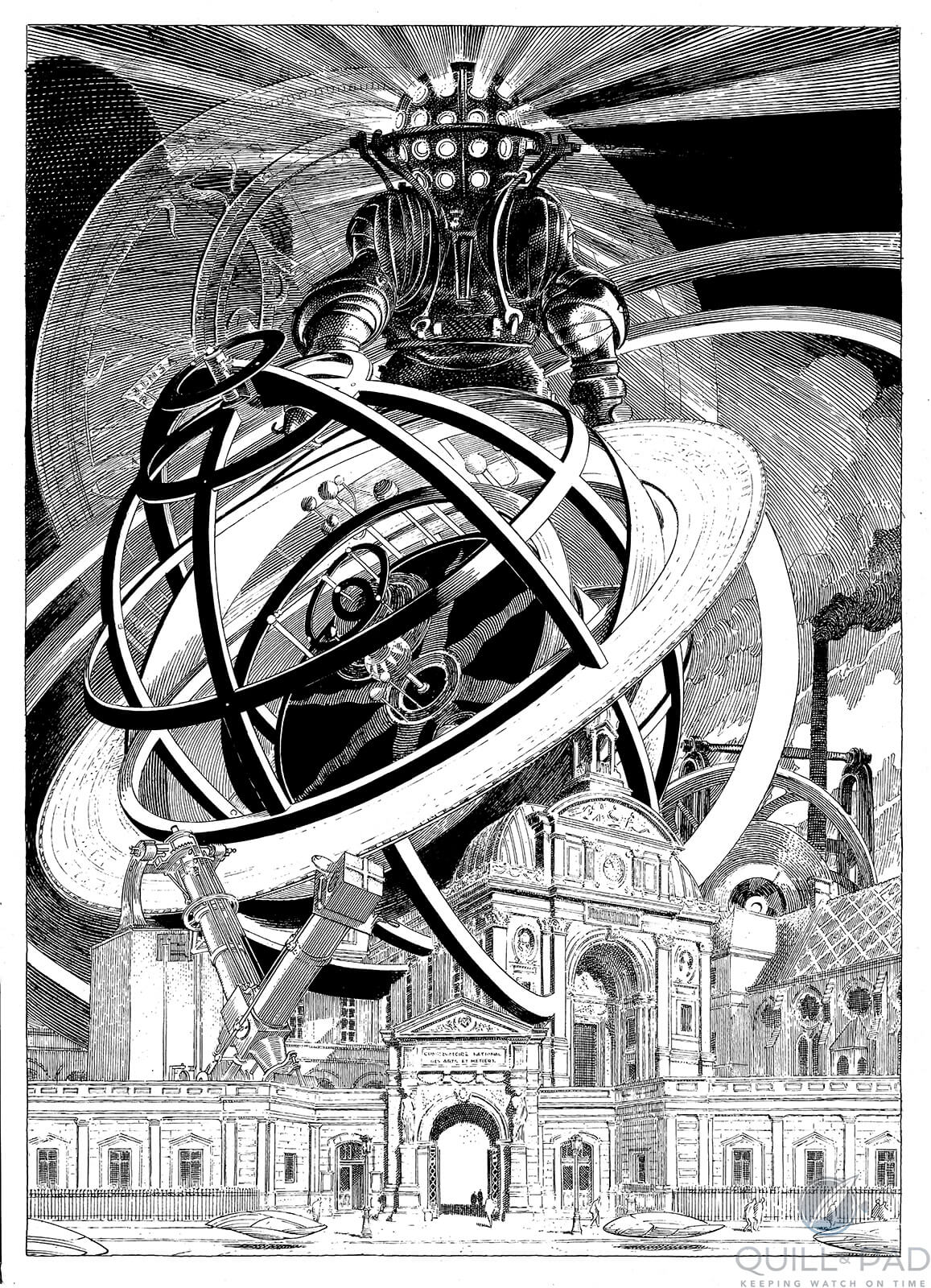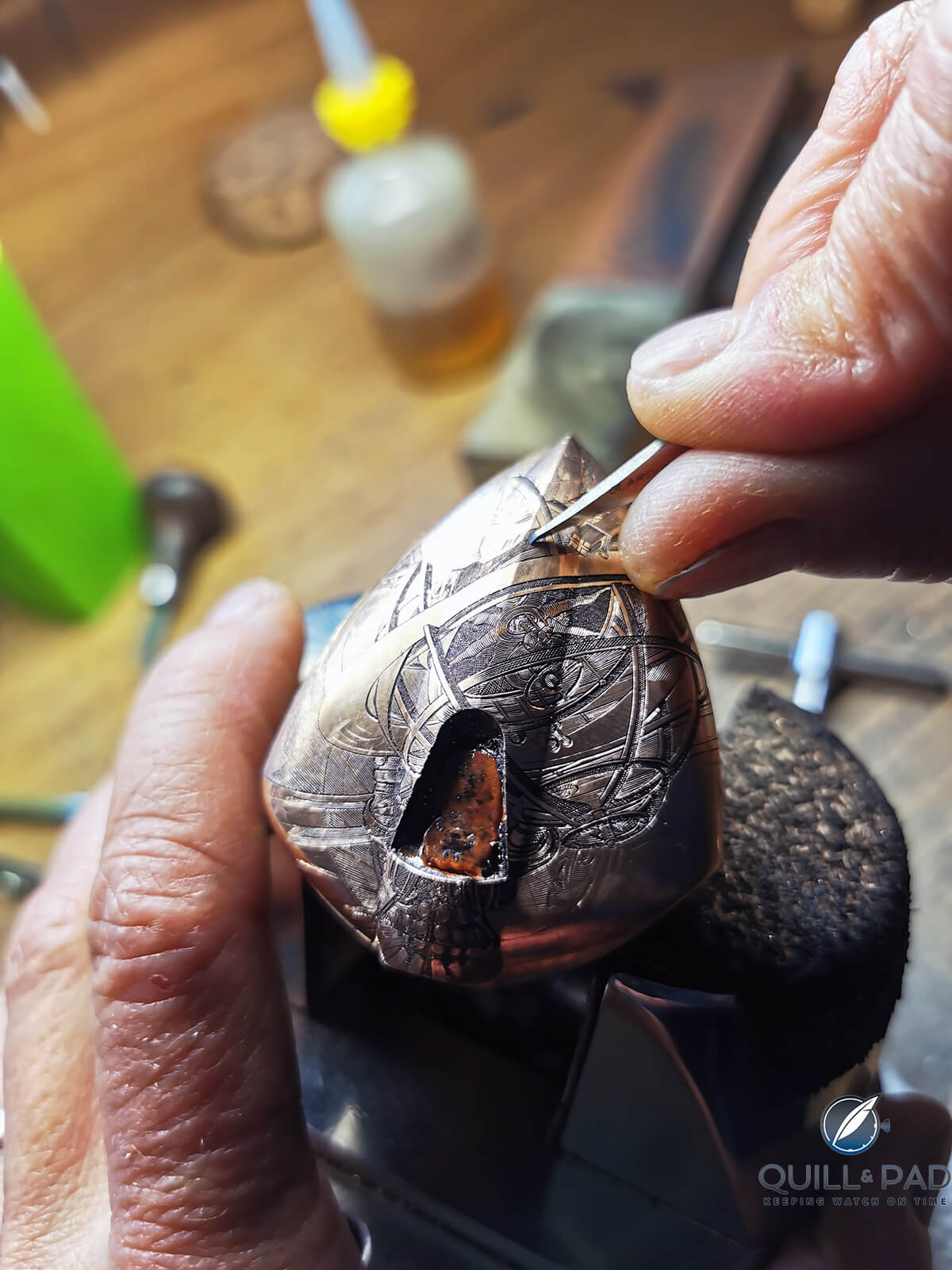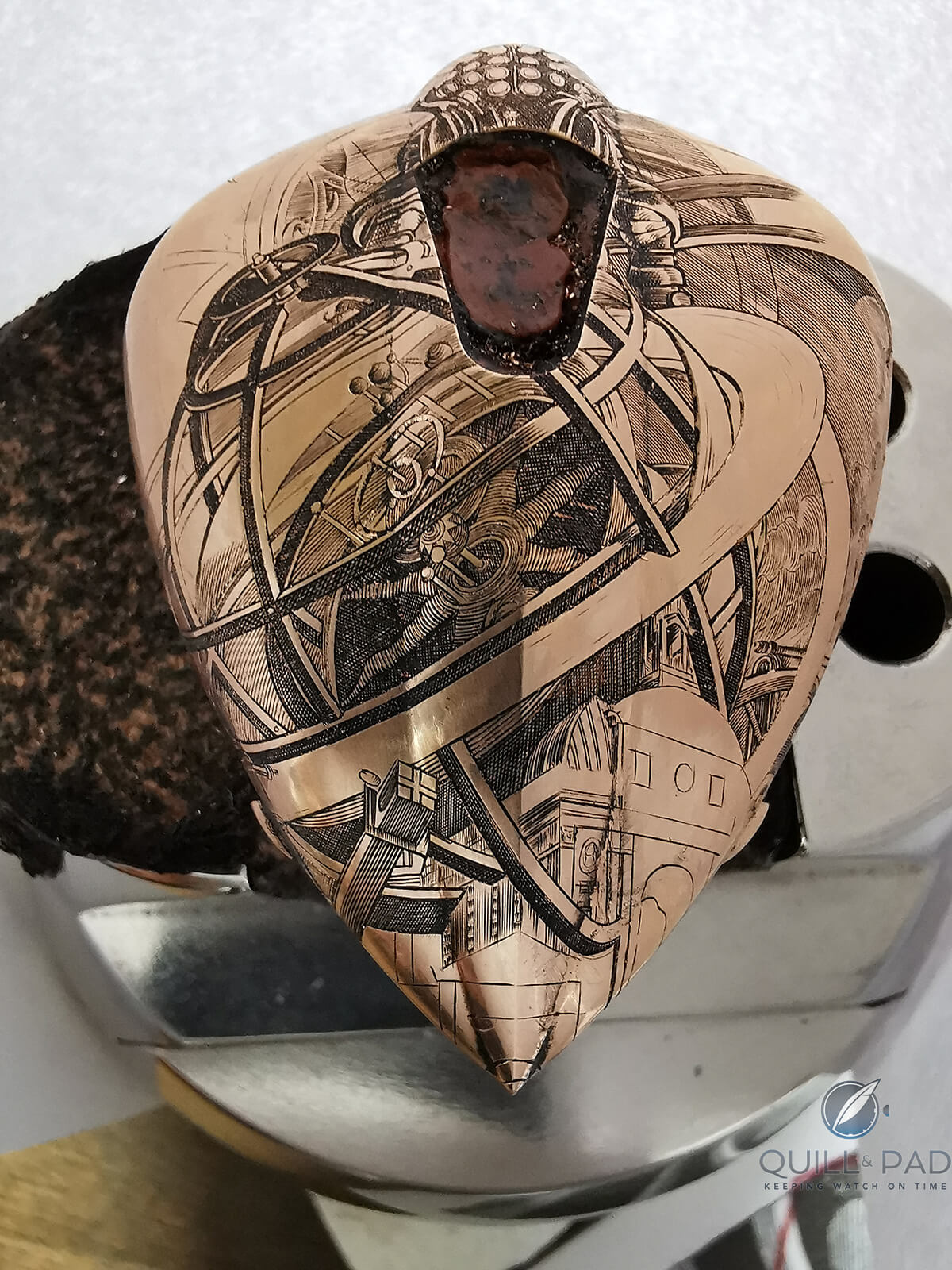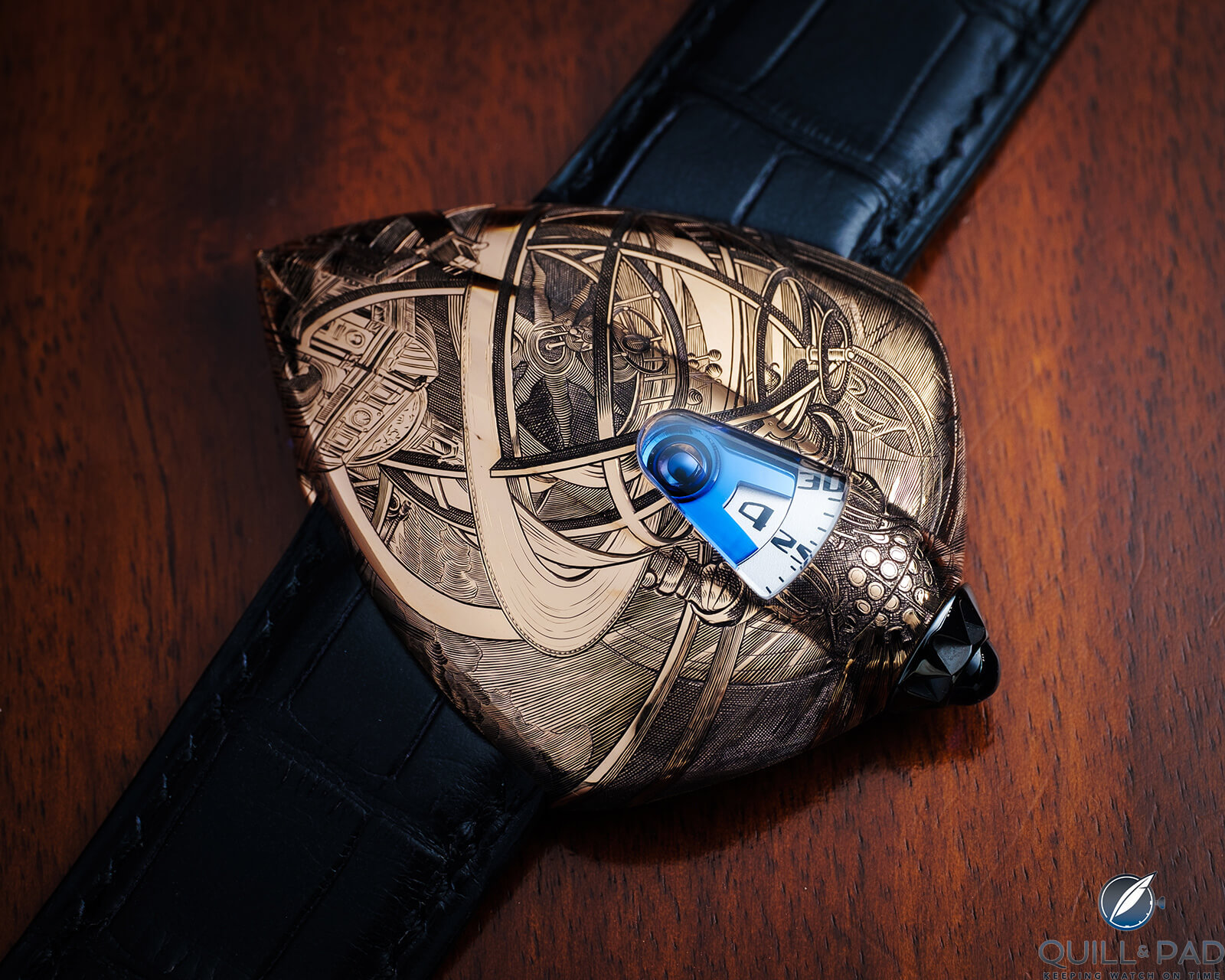Tomorrow will look different than today, and artists have always tried to predict what it might look like. But some artists don’t attempt to imagine what the future of our world will be and instead imagine what an alternate world might be if certain changes were made.

De Bethune DW5 Armilia
A pair of friends, Belgian comic artist François Schuiten and writer Benoit Peeters, went in a direction that is a dramatic vision of an alternate earth.
In the graphic novel series The Obscure Cities, the duo imagined a world that orbited perfectly opposite the earth on the same orbital path, thus making it permanently obscured by the sun.
On this world, humans have organized themselves into independent city-states that all feature unique architecture, technology, and culture. The cities are a mishmash of classical architectural styles mixed with brutal industrial shapes and steampunk-esque technologies that underpin each society.
The illustrations making up the graphic novels are superb and jarring, filled with combinations of the real with the absurd. In one image, a provincial city exists within an enormous book perched on a hillside, while in another, a modern landscape of skyscrapers is intertwined with glowing paths melding lush foliage with the city structures.
The concepts built into these cities highlight ideas of utopias versus dystopias and how the truth is often just based on perspective.
In one of the novels, the pair presents the city of Armilia, a submerged, nearly underground city tasked with the control of time. Due to the immensely intermingled nature of time, the city also ends up with an outsize influence on climate, often leading to disruptions.

Illustration of the city of Armilia
An incredibly detailed drawing of the city imagines a gothic cathedral and grounds magically interlocked with a gigantic armillary sphere containing an orrery at its center. The monstrous structure is manipulated by a robotic humanoid titan, all while the tiny humans go about their day, strolling along while hovering vehicles pass by.

De Bethune’s DW5 Armilia in the display case at bottom right (photo courtesy De Bethune/Amr Sindi)
This original drawing in combination with the entirety of The Obscure Cities provided the inspiration to De Bethune co-founder Denis Flageollet to create a unique version of the out-of-this-world Dream Watch 5 (DW5) to join an exhibition at Maison d’Ailleurs: Museum of Science Fiction, Utopias, and Extraordinary Journeys.
The exhibition is called “(im)Perfect Worlds” (“Mondes imParfaits” in French) and highlights not only Schuiten and Peeters’ The Obscure Cities, but also art by Louis Loup Collet, Thomas Crausaz, and a variety of novels, comic books, and films that cover the topic of utopian and dystopian worlds.
Perfectionism, dystopias, and us
Flageollet grabbed hold of the concept of perfection in utopian environments and the reality of the dystopia often lurking underneath and spoke of its relation to craftspeople and how they view their own work.
He illustrates how the imperfect nature of handmade work is what truly creates the emotion from artistic crafts, since they don’t come “out of machines and industries that format everything they produce.”

De Bethune DW5 Armilia
The DW5 Armilia follows the same paths as Schuiten’s drawings and the imaginary societies within them. In search of perfection and the utopian ideal, the flaws of the real enter to make the world anything but perfect, and this seeks to remind us that while striving for perfection is a laudable goal, human error and variability are inevitably present in the great works of craftsmanship and art.
And what better way to highlight that truth than by an incredibly complex hand-engraving of a dystopian world on the case of an awesomely precise piece of horology.
The DW5 is supposed to be, as its name suggests, a fantasy object, a dream of sci-fi splendor. Out of all the Dream Watch editions, the DW5 is by far the most fantasy inspired and it has a good claim of being simply perfect.
When the first version of the DW5 launched in 2014, it stood out not for its blatant complexity, but for its seeming lack of complexity.
De Bethune Dream Watch 5 in all its glory
The basis for the DW5 was similar to the DB28 Digitale, which came out at the same time.

De Bethune DB28 Digitale
Both watches center around a simple display with continuous minutes, jump hours (gotta love it), and the spherical moon phase that De Bethune is famous for. But while the DB28 Digitale checked off a lot of boxes for the typical collector, the Dream Watch 5 was for those who appreciate the unknown and unimaginable.

De Bethune Dream Watch 5 on the wrist
The watch clearly sports the design of a futuristic spaceship from a much more advanced species that traveled through the galaxy to reach our rocky little planet.

De Bethune Dream Watch 5, a unique piece encased in blued meteorite
The first version in polished titanium was a beauty, but the follow-up with a case made out of meteorite was what truly became a spaceship. The gorgeous colors and features of the meteorite made the case appear as though it perfectly reflected a stunning galaxy of stars, nebula, and supernovae.
But now, the DW5 Armilia tells a story closer to home, one of a planetary twin to our own, but with technology we can only comprehend as magic. It is also the first one that feels truly human instead of out of this world.

Engraving the case of the De Bethune DW5 Armilia
The painstaking engraving acts as a manifestation of our humanity, showing the imaginary realm of Armilia, but also the delicate world of Swiss master engraver Michelle Roten.

Case of the De Bethune DW5 Armilia
The scene on the 18-karat pink gold case is the same as described above, with the dark lines standing out against the warmth of the gold. The natural hues of the case make way, however, for the extremely bold blued titanium in the viewing window and the polished one-carat blue sapphire cabochon in the ion-thruster inspired crown.

Silicon balance wheel visible on the back of the De Bethune DW5 Armilia
There is another peek at some stunning blue on the rear of the DW5 Armilia where a small crystal shows the silicon balance, balance bridge, and movement plate all in blue.
But no matter how awesome the DB2144V2 caliber is (because every De Bethune caliber is fantastic), the DW5 Armilia is not just about the watch anymore. If the engraving didn’t make it obvious, and Flageollet giving a speech at the opening of “Mondes imParfaits” didn’t seal the deal, then the source material of The Obscure Cities can serve as a starting point for a much deeper philosophy lesson.
If you aren’t in the mood for philosophy then the visuals should be more than enough to evoke a visceral emotional response, something at the base of your spine that tingles for revelation.

De Bethune DW5 Armilia
The DW5 has been a very visceral watch for the last five years, and with the addition of the new Armilia the collection stands as one of the most sci-fi watches on the market. And it’s all built on a dream.
So while I fade into a daydream, how about we break the Armilia into something more approachable?
- Wowza Factor * 9.9 It’s hard to imagine something grabbing my attention with a wowza more than this piece!
- Late Night Lust Appeal * 99.9» 979.684m/s2 Enough lust worthiness to sink a chat hard.
- M.G.R. * 65.5 What you can find in a movement these days, enough to rank well!
- Added-Functionitis * Mild If you are only going to have one added function, it sure helps if that function is a moon phase accurate to one day every 1,112 years. Still, you’ll only need children’s strength Gotta-HAVE-That cream for some intense horology!
- Ouch Outline * 12.1 The pounding of your brain behind your eyes! Some are unfortunate enough to understand what a migraine is, and if you are one you have my sympathy. I don’t know if I would take it willingly, but if it got me one of these watches I’d probably be more forgiving!
- Mermaid Moment * The engraving speaks to my soul! It’s hard to describe what art can inspire, yet the DW5 Armilia has made me want to shout it from the rooftops and walk down the aisle!
- Awesome Total * 822 Begin with the years of accuracy of the moon phase mechanism (1,112) and subtract the number of components in the movement (320), then add the water resistance in meters (30) for an out-of-this-world awesome total!
For more information, please visit www.debethune.ch/De_Bethune_Maestri_Art_DW5_Armilia.
Quick Facts De Bethune Maestri’Art DW5 Armilia
Case: 58 x 47 x 16 mm, pink gold, crown set with one-carat blue sapphire
Movement: manual winding Caliber DB2144V2, 4 Hz (28,800 vph) frequency, 5-day power reserve, self-regulating twin spring barrels, silicon annular balance, silicon escape wheel
Functions: jump hours, minutes; spherical moon phase
Limitation: one unique piece
Price: CHF 190,000
You may also enjoy:
The Nine Muses And The De Bethune DB28 Digitale
De Bethune DB28 Kind Of Blue Tourbillon: The Blues Have Never Been So Joyful
De Bethune DB28 Steel Wheels: An On-The-Wrist Review (With Lots Of Photos)
How Do You Top The Sensational De Bethune DB28 Maxichrono? By Customizing It, Of Course





















































Leave a Reply
Want to join the discussion?Feel free to contribute!